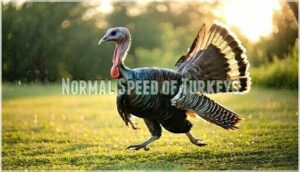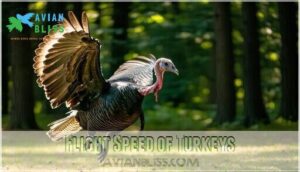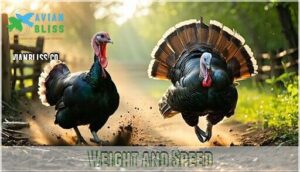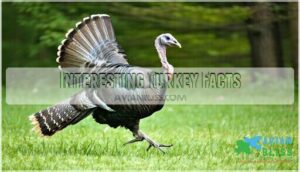This site is supported by our readers. We may earn a commission, at no cost to you, if you purchase through links.

That’s faster than most people can jog! A frightened turkey uses its powerful legs to escape danger, and those speeds can catch hunters and hikers off guard.
Wild turkeys are much quicker than their domestic cousins, who’ve been bred for size rather than speed.
These birds don’t just rely on running though – they can also burst into flight at 55 mph when really panicked.
Understanding turkey speed helps explain why they’re such successful survivors in the wild, and how they can achieve this through their ability to run and fly, making them very powerful legs users.
Table Of Contents
Key Takeaways
- You’ll be amazed that spooked turkeys can sprint up to 25 mph on the ground – that’s faster than most people can jog, making them surprisingly quick escape artists when threatened.
- You should know that wild turkeys can burst into flight at 55 mph when really panicked, giving them a dual-speed escape system that’s much more effective than just running alone.
- You’ll find that wild turkeys are significantly faster than their domestic cousins, who’ve been bred for size rather than speed and can only waddle at about 6 mph maximum.
- You need to understand that a turkey’s weight, fear level, and age all affect their running speed – lighter, younger, and more frightened turkeys will always outrun heavier, older, or calmer ones, and this makes them effective escape artists with a unique ability to burst into flight.
Turkey Speed and Flight
You’ll be amazed to learn that a spooked wild turkey can sprint up to 25 miles per hour on the ground and reach flight speeds of 55 miles per hour when startled.
Wild turkeys are nature’s feathered race cars, exploding from zero to 25 mph faster than most people can blink.
These impressive speeds help turkeys escape predators quickly, whether they’re running through forests or bursting into the air like feathered rockets.
Wild turkeys transform from casual foragers into lightning-fast escape artists when danger strikes.
Normal Speed of Turkeys
When someone encounters a turkey in the wild, they’re often surprised by how quickly these birds can move.
Understanding turkey speed helps explain why they’re such successful survivors in nature.
Here are 5 key facts about normal turkey running speeds:
- Average Velocity: Wild turkeys typically run at 20-25 mph when moving at normal pace
- Domestic Speeds: Farm-raised turkeys average around 20 mph due to their heavier build
- Wild Speeds: Wild turkeys can reach up to 25 mph with their lean, muscular frames
- Terrain Impact: Flat ground allows maximum speed, while hills and obstacles slow them down
- Age Influence: Younger turkeys run faster than older birds, just like humans
A spooked turkey’s explosive burst from cover demonstrates remarkable turkey escape abilities.
Their powerful leg muscles generate impressive acceleration that catches most people off guard.
This turkey running speed serves as their primary defense mechanism.
Whether you’re hunting or just hiking, knowing how fast these birds can move helps you appreciate their survival skills.
Most predators can’t match a turkey’s quick getaway speed across varied terrain.
Flight Speed of Turkeys
When spooked turkeys can’t outrun danger on foot, they’ll launch into the air with surprising takeoff velocity. These birds reach burst speed of 50-55 mph during flight, with some sources reporting speeds up to 80 mph when seriously threatened.
That’s faster than most cars driving through your neighborhood! Wild turkeys maintain flight altitude close to the ground, typically flying around 400 meters (about a quarter mile) before landing.
Their aerial maneuvers might look clumsy, but they’re surprisingly effective at dodging threats. Unlike their domestic cousins who struggle with sustained flight due to their heavy build, wild turkeys use their strong chest muscles for these explosive escapes.
A spooked turkey’s flight distance covers enough ground to quickly escape most predators. Turkey flight serves as their backup plan when turkey running isn’t enough. Understanding how fast these birds can move through the air helps explain why turkey speed has kept them thriving in the wild for centuries.
Factors Affecting Turkey Speed
When you’re trying to understand turkey speed, you’ll find that several key factors determine how fast these birds can move.
A turkey’s weight, fear level, age, and the terrain it’s running on all play important roles in whether it reaches those impressive 25 mph speeds or moves more slowly, which can be influenced by its fear level.
Fear Level and Speed
When you witness a turkey’s panic acceleration, you’re seeing nature’s stress response in action. A frightened turkey transforms from a casual forager into a speed demon within seconds.
Their adrenaline boost kicks in immediately, flooding their system with stress hormones that supercharge their muscles for maximum escape velocity. The fear level directly impacts how fast spooked turkeys move.
Mild disturbances might trigger a quick trot, but genuine perceived threats launch them into full sprint mode. Turkey running speed jumps from their normal 5-10 mph pace to an explosive 25 mph burst when truly spooked. Birds’ flight initiation distance increases with speed.
Here’s what happens during their stress response:
- Heart rate spikes dramatically, pumping oxygen-rich blood to leg muscles
- Flight vs. run calculations happen instantly based on threat proximity
- Muscle tension increases, preparing for explosive movement
- Reaction time drops below one second for immediate escape
How fast a turkey moves depends entirely on how scared they feel in that moment, which is a result of their natural stress response.
Weight and Speed
Every turkey’s weight directly affects how fast it can run when spooked.
You’ll notice wild turkeys typically weigh 8-22 pounds and can hit speeds up to 25 mph.
Domestic turkeys, however, often weigh much more and move substantially slower.
Weight Impact shows clearly in turkey speed performance.
Muscle Mass and Body Composition determine whether a turkey can sprint or just waddle away from danger.
Age Correlation matters too – younger turkeys run faster than older ones.
Breed Variance creates huge differences in turkey speed capabilities.
| Turkey Type | Weight Range | Max Running Speed |
|---|---|---|
| Wild Tom | 16-22 lbs | 25 mph |
| Wild Hen | 8-12 lbs | 25 mph |
| Domestic Turkey | 20-40 lbs | 15 mph |
| Young Poult | 2-8 lbs | 20 mph |
| Heavy Breeder | 30+ lbs | 10 mph |
When you encounter a spooked turkey, remember that lighter birds will outrun heavier ones every time.
How fast they move depends entirely on what they’re carrying around.
Comparison to Other Birds
You might wonder how turkeys stack up against other birds in terms of running speed.
While a spooked turkey can hit 25 mph on the ground, they’re actually among the ten fastest running birds, though they can’t match the 43 mph top speed of ostriches or roadrunners.
Comparison to Domestic Turkeys
You’ll notice dramatic Agility Differences between wild and domestic turkeys when they’re spooked. A spooked turkey in the wild can sprint up to 25 mph, while domestic birds waddle at just 6 mph maximum.
Selective Breeding has transformed farm turkeys into meat machines, sacrificing speed for size. The wild turkey, or Meleagris gallopavo species, is native to North America.
| Feature | Wild Turkey | Domestic Turkey |
|---|---|---|
| Turkey Speed | 25 mph | 6 mph |
| Weight Impact | 16-22 lbs | 30+ lbs |
| Flight Ability | 55 mph bursts | Rarely flies |
| Survival Skills | Sharp instincts | Reduced reflexes |
How fast can your backyard bird move? Not very. Wild turkey specimens maintain their ancestral athleticism, while domestic turkey breeds can barely manage a brisk walk. It’s like comparing a marathon runner to someone carrying a heavy backpack.
Comparison to Wild Turkeys
While domestic turkeys waddle around farms, wild turkeys showcase remarkable agility differences that’ll surprise you.
These athletic birds demonstrate superior survival rates through their streamlined builds and enhanced evasion tactics.
| Characteristic | Wild Turkey |
|---|---|
| Turkey Speed | Up to 25 mph running |
| Flight Speed | 50-55 mph bursts |
| Build | Lean, athletic frame |
| Habitat Preference | Dense forests, open fields |
| Diet Variations |
Diverse foraging skills.
When a spooked turkey detects danger, that turkey running speed kicks into high gear instantly.
Comparison to Other Large Birds
When comparing turkey speed to other large birds, you’ll find turkeys hold their own pretty well.
A spooked turkey hits 25 mph, which isn’t shabby compared to these feathered speedsters:
| Bird Species | Top Running Speed |
|---|---|
| Ostrich | 45 mph |
| Emu | 30 mph |
| Cassowary | 30 mph |
Ostrich speed dominates the field, but turkey speed matches emu agility and cassowary danger levels surprisingly well for their size.
Hunting Tips for Spooked Turkeys
When you’re hunting turkeys that can sprint up to 25 mph, you’ll need smart tactics to stay ahead of their lightning-fast escape routes.
Keep your movements silent and avoid loud noises, since a spooked turkey’s speed can turn your hunting trip into a frustrating chase through the woods, requiring quick thinking to recover.
Avoiding Loud Noises
Successfully avoiding loud noises requires understanding turkey noise sensitivity and their incredible hearing abilities. When turkeys detect sudden disturbance, they’ll bolt at 25 mph before you blink.
Sound mitigation becomes essential for hunting success in quiet environments. This is crucial because even slight noises can scare turkeys away.
Follow these decibel levels guidelines:
- Whisper when communicating with hunting partners
- Use noise-dampening equipment on all gear
- Step carefully to avoid breaking branches underfoot
- Close vehicle doors softly when arriving at locations
- Practice calming turkeys through gentle, natural sounds
This turkey defense strategy prevents spooked turkey situations entirely, making it a valuable approach for hunters to master.
Avoiding Dogs
Dogs trigger a spooked turkey’s predator evasion instincts faster than anything else.
When turkeys detect canine scents or sounds, their escape behavior kicks into overdrive.
They’ll sprint at 25 mph or take flight at 50 mph without hesitation.
Different dog breeds pose varying threat levels to turkeys, but all domestic dogs represent danger in a turkey’s mind.
Leave your hunting companion at home or secure them in safe havens away from your hunting area.
Even well-trained dogs with excellent training methods can’t suppress their natural instincts around wild birds.
Leash laws exist for good reason – free-roaming dogs destroy turkey defense mechanisms and ruin hunting opportunities for miles around.
Using Red Lens Flashlights
Red light benefits become essential when tracking spooked turkeys in low-light conditions. Your standard flashlight’s white beam disrupts turkey night vision and triggers their escape behavior, sending them running at speeds up to 25 mph.
Red lens options preserve their natural sight while giving you flashlight beam distance for safe navigation. This hunting application works because turkeys can’t detect red wavelengths as easily, reducing predator evasion responses.
Consider purchasing a flashlight for ideal results. Choose LED red lights with adjustable brightness to maintain your advantage.
The dimmer setting keeps spooked turkey behavior calm while providing enough visibility for your approach through dense cover, making red lens options a valuable tool for hunters.
Silent Movements
Why alert every turkey within a mile radius when you can move like a ghost? Master camouflage tactics by staying low and using natural cover to blend with your surroundings.
Control your footstep sound by placing heel-to-toe on soft ground, avoiding branches that snap. A spooked turkey can hit 25 mph instantly, so quiet roosting approaches matter.
Study their stealthy foraging patterns and predator avoidance behaviors. Move during windy conditions when natural sounds mask your presence.
Consider investing in specialized hunting apparel for enhanced stealth. Remember, turkey behavior changes dramatically when they sense danger – one wrong move triggers their lightning-fast predator escape response.
Understanding Turkey Behavior
You can’t predict a turkey’s next move without understanding what drives their daily actions and reactions.
Learning their roosting habits, foraging patterns, and communication signals helps you anticipate when they’ll bolt at 25 mph or take flight at 55 mph.
Roosting Habits
When nightfall arrives, turkeys transform from ground-dwelling birds into skilled tree climbers. These clever birds choose roosting elevation between 20-50 feet high for ideal predator avoidance.
Their nocturnal behavior involves selecting sturdy oak, pine, or elm branches that can support their weight. Wild turkeys often practice communal roosting, gathering in groups for added safety.
Seasonal changes affect their roost selection—they’ll pick denser cover during winter months. A spooked turkey’s running speed helps them reach safety, but their turkey predator response relies heavily on elevated sleeping spots for nighttime protection.
This behavior contrasts with other birds that exhibit fascinating mobbing behavior, highlighting the unique aspects of nocturnal behavior in turkeys.
Foraging Patterns
Understanding turkey behavior helps you predict when a spooked turkey might bolt at top running speed.
Turkeys follow predictable foraging patterns that vary by season and food availability. Their group size and habitat influence affect daily routines.
Here’s what drives turkey foraging behavior:
- Dawn chorus – Gobblers announce foraging time with loud calls
- Favorite spots – They revisit productive feeding areas repeatedly
- Evening chatter – Content purring signals successful foraging days
Smart hunters use these seasonal diet patterns to their advantage.
Communication Signals
Watching foraging turkeys reveals their rich communication system.
These birds use complex turkey vocalizations and visual displays to share information about danger, food, and social status. When a spooked turkey detects threats, it sends alarm calls that trigger instant running responses throughout the flock.
Here are 5 key turkey communication signals:
- Gobbling – Males announce territory and attract mates
- Yelping – Basic contact call between flock members
- Purring – Contentment sound during feeding or dust bathing
- Cutting – Excited, rapid calls signaling agitation
- Drumming – Low-frequency mating display from toms
Understanding bird communication helps explain turkey behavior and their lightning-fast running speed when alarmed. Social hierarchy determines who responds first to danger signals.
Interesting Turkey Facts
You’ll discover that turkeys have some surprising behaviors beyond their impressive speed, from their unusual reactions to weather to their complex social habits.
These fascinating birds show remarkable intelligence and unique traits that make them far more interesting than most people realize, with complex social habits being a key aspect of their behavior.
Turkey Heart Attacks
Turkey heart attacks sound bizarre, but they’re real.
A frightened turkey’s survival instincts can backfire when extreme stress overwhelms their cardiovascular system.
Domestic turkeys face higher risk factors than wild ones, experiencing 2-5% cardiomyopathy rates early in life.
Loud noises, sudden movements, and predator threats trigger these episodes.
Symptoms include rapid breathing and collapse.
Prevention involves minimizing disturbances around flocks.
While turkey running speed helps escape danger, sometimes their hearts can’t handle the adrenaline rush.
Turkey Rain Behavior
Ever watched a turkey get caught in the rain? These birds tilt their heads upward during downpours, creating a risky situation.
Rain Head Tilting can cause water to pool in their nostrils, potentially leading to drowning.
Wet Feather Impact affects their turkey running speed and agility.
Smart turkeys seek Shelter Seeking behavior, abandoning Foraging in Rain activities while maintaining Predator Avoidance through reduced turkey running response during storms, utilizing Rain to their advantage.
Turkey Reproduction
When you witness turkey reproduction firsthand, you’ll see nature’s impressive timing at work.
During breeding season, hens lay 10-12 eggs over two weeks with careful egg laying precision. The incubation period lasts exactly 28 days before poult development begins.
What’s remarkable about turkey running speed becomes clear immediately – these babies hatch ready to sprint alongside mom at impressive turkey speed within hours.
This instant mobility gives poults their best chance at survival, requiring minimal parental care compared to other birds, which is a result of their ability to move quickly and efficiently, showcasing their impressive timing and instant mobility.
Gender Differences
Beyond reproduction patterns, you’ll notice striking differences between male and female turkeys that affect their running speed and agility.
Males typically outweigh females by nearly double, creating a clear size disparity that impacts their escape abilities.
Here are the key gender differences you should recognize:
- Male Speed: Toms reach 20-25 mph despite their heavier 16-22 pound frames
- Female Agility: Hens move more nimbly at similar speeds with their lighter 8-12 pound bodies
- Spur Influence: Males’ sharp spurs provide better ground traction during sprints
- Plumage Impact: Males’ elaborate feathers create slight drag but don’t substantially reduce bird speed
- Size Disparity: Females’ compact build offers superior maneuverability in tight spaces
This animal speed variation between genders affects hunting strategies and predator evasion tactics. These differences highlight how bird anatomy functions to support varied physical capabilities.
Frequently Asked Questions (FAQs)
How fast can a spooked Turkey fly?
Like a feathered fighter jet taking off, you’ll witness a spooked turkey burst into flight at incredible speeds of 50-55 mph.
They can’t sustain this pace long, but it’s enough to escape danger quickly, with speeds that can be considered incredible.
How fast can a Turkey Run?
Wild turkeys can run up to 25 miles per hour when threatened or frightened. Domestic turkeys average around 20 mph. Their powerful legs help them escape predators quickly across various terrain.
Are wild turkeys fast?
Don’t let their awkward waddle fool you—wild turkeys are surprisingly fast runners.
They’ll outpace you at 25 mph when spooked, and can burst into flight at 55 mph.
You’d lose that race every time.
Do turkeys run uphill?
Yes, turkeys can run uphill effectively using their powerful leg muscles.
You’ll find they’re surprisingly agile on slopes, maintaining decent speed even when climbing.
Their muscular build helps them navigate varied terrain when escaping predators.
How do turkeys survive a predator?
When push comes to shove, you’ll see turkeys bolt at 25 mph or burst into flight at 55 mph.
They’ll sprint first, then take wing if needed, using their dual-speed escape plan to outrun coyotes and foxes.
Can wild turkeys fly?
These birds can fly up to 55 mph in short bursts when startled. They’ll burst off the ground like feathered rockets, covering a quarter-mile before landing. Flight’s their ace escape card.
How fast can a turkey run when spooked?
When you startle a turkey, it’ll bolt at speeds up to 25 miles per hour.
That’s fast enough to outrun most people!
Their powerful legs kick into high gear, helping them escape danger in a flash.
Will a spooked turkey come back?
Like a boomerang thrown into the wind, spooked turkeys don’t vanish forever.
They’ll typically return to their bedding areas within hours, depending on how badly you scared them and what caused the disturbance.
Can a human outrun a wild turkey?
Most humans can’t outrun a wild turkey.
You’d need to sprint at 25+ mph to match their speed, which exceeds average human running ability.
Turkeys will likely escape you on foot every time, due to their speed.
How fast can turkeys run up to?
Turkeys can reach impressive running speeds of up to 25 miles per hour when they’re frightened or pursuing prey.
Wild turkeys are faster than domestic ones, using their powerful leg muscles for quick escapes.
Conclusion
Knowledge is power when you’re dealing with wildlife encounters.
Now you know how fast can a spooked turkey run – up to 25 mph on the ground and 55 mph in flight.
These impressive speeds make turkeys formidable escape artists in the wild.
Whether you’re hunting, hiking, or just curious about nature, understanding turkey behavior and speed capabilities helps you appreciate these remarkable birds.
Remember, a frightened turkey’s quick reflexes and powerful legs make them surprisingly fast runners when danger strikes, showcasing their powerful legs.
- https://www.reddit.com/r/whowouldwin/comments/r14uez/how_many_wild_turkeys_does_it_take_to_overwhelm_a/
- https://mossyoakgamekeeper.com/uncategorized/wild-turkey-truths-its-a-fact/
- https://gizmodo.com/you-dont-know-turkey-about-wild-turkeys-1695110997
- https://encyclopedia.pub/entry/34795
- https://ucanr.edu/blog/real-dirt/article/game-birds-north-state-wild-turkey-and-quail











